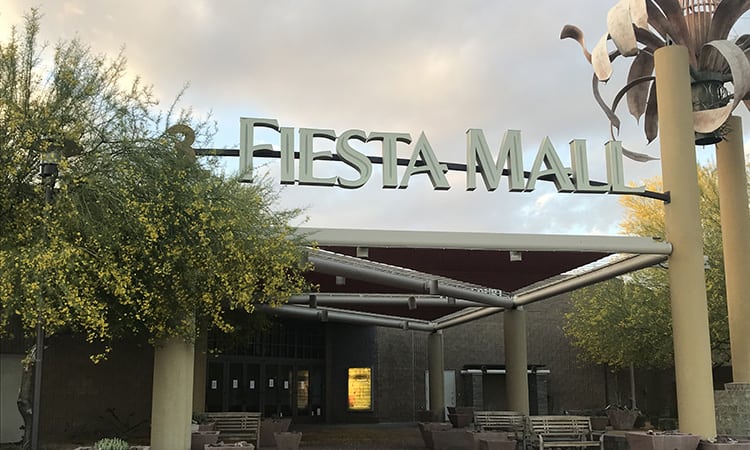Recent mall closures in Mesa and Phoenix may not paint a rosy picture of the future, but the day-to-day decision-makers say these failures are providing the backdrop for a convergence of ideas that may leave their communities better off.
“Sometimes, something has to fail before something cool can happen,” said Christine Mackay, economic development director of the city of Phoenix.
In Phoenix and across the country, retailers are responding to what they see from customers irrespective of market — a desire to live, work and be entertained in one place.
Malls are reimagining themselves to try and better meet their communities’ needs as mixed-use facilities that house service businesses, restaurants, homes and entertainment venues.
Metrocenter in Phoenix has used a newly opened Walmart location to attract new business, while in Mesa, new owners at the once-thriving Fiesta Mall say they are trying to find tenants from the education and health services sector to replace ailing big box department stores. At Scottsdale Fashion Square, a new expansion represents fresh investment in the mall’s existing model from owners at the national retail company Macerich.
A potential economic engine for northwest Phoenix
Warren Fink, the chief operating officer at Carlyle Development Group, which is an operating partner and part-owner of Metrocenter said retail will still be a part of his business, but the mall’s other future uses will complement the stores.
Fink imagines a situation at Metrocenter in which people who live at the mall would be able to find a comfortable home, a variety of meal options, and venture out to be entertained, all on one property.
Rather than a problem, Mackay positioned Metrocenter as a potential “economic engine” for northwest Phoenix if it can regain its place as an entertainment destination, where errands are an excuse to spend time in the place.
“When the retail starts to fall, it acts like a cancer and spreads into the neighborhoods,” Mackay said. “It causes property values to fall, it causes crime issues, because there is this big, vacant property that there aren’t as many eyes watching.”
Fink said part of the problem that led to Metrocenter’s decline is an overall problem in Phoenix of having more stores than people to shop in them. Mackay explained that Phoenix has 46 square feet of retail space for every person, a large number when compared with the national average of 32 square feet per person.
To that end, Fink said his company has already re-zoned the Metrocenter property for residential and restaurant use. The Walmart store moved into a vacant unit in October 2017, and Fink said it has done well and begun to attract other supporting tenants. He added that the Valley Metro Rail expansion, which will place a stop in front of the mall by 2023, could attract professional office spaces and family and senior housing.
The Northwest Phase II expansion of the Metro Rail will extend the track down Dunlap Avenue to 25th Avenue and up that street toward Metrocenter and Rose Mofford Sports Complex, according to the Valley Metro website. The plan, which would go into effect by 2023, is awaiting final approval by the city.
“It’s a matter of trying to find a formula that will take care of the local demographic,” Fink said. He later added that the Metrocenter community houses the “worker bees of Phoenix.” This led him to believe apartments could thrive alongside big retail brands like Walmart when his company acquired the facility.
Total vacancies in metro Phoenix were down nearly a full percent last year compared with the end of 2016, a Colliers International report from late last year showed. The demand for brick-and-mortar retailers seems to keep these stores in the Valley, ready to re-enter the market as it recovers.
However, Sears Holdings announced in late May it would close the Sears location at Metrocenter, which had previously been one of the last holdouts at the mall.
And yet, in a sign that Phoenix may be a profitable market for healthy new jobs like the ones Fink hopes to add at Metrocenter, Mackay said that Phoenix has become the third largest employer in the financial services sector, behind only Wall Street and Dallas. Metrocenter has the chance to become an early success story in the city if its reformulation goes according to plan.
Building out a redevelopment district in Mesa
“Consumerism has evolved dramatically with the availability of online shopping,” said Ray Cashen, the president of Cashen Realty Advisors, which is in charge of marketing and leasing at Fiesta Mall. “It has made all these retailers start to reduce the size of their footprint.”
Fiesta Mall, at the center of what Mesa Economic Development Director Bill Jabjiniak called the city’s redevelopment area, is down to just one major retail tenant, Dillard’s Clearance Center. Since Dimension Financial took ownership of most of the property last year, Cashen’s company has been in conversation with health and education services companies to infill and redefine the property as another mixed-use facility.
The new owners of Fiesta Mall, Dimension Financial & Realty Investments Inc., purchased Fiesta Mall for $6.72 million with plans to invest $30 million into the Mesa mall.
Jabjiniak said it is the city’s goal to build out the business district around Fiesta Mall. Mesa has three residents for every job, he said, outlining the real thrust behind the city’s emphasis on redeveloping the area surrounding the mall. The number of jobs created, dollars invested, and square footage of space absorbed by tenants are the basic metrics Jabjiniak said he looks at to determine whether a project will lead to economic growth.
“Retail tends to be a lower-wage job,” Jabjiniak said. “Communities that chase just a retail job or are after bottom-line sales tax dollars are different than those that chase the high-value, high-wage job.”
People who move to a city for other valuable, lucrative jobs bring with them a demand for quality housing, creating a climate of growth that elevates the city’s entire economy.
Marc Rogers, the owner of Fade Tite barbershop, has stuck out the difficult times in Fiesta Mall and still maintains a unit alongside Dillard’s Clearance Center.
Rogers said he believes his shop will be successful when new businesses fill the units around him at the mall, thanks to the young professionals who will hopefully populate the mall again, though he admitted it was difficult seeing his colleagues unable to make it work at the mall.
“Once the bigger stores started closing down, the walk-in traffic went with it. So the smaller kiosks that depended on the walk-in business couldn’t handle it,” Rogers said.
The owner prior to Dimension created shorter contracts at Fiesta Mall because the company knew it would eventually flip the property again, said Cashen. “We were lucky that the vast majority of the leases were short-term,” he said. “Some were even month-to-month.”
This allowed Cashen and his company to act quickly in their effort to replace the big box stores with newer, more desirable tenants such as doctor’s offices and technical schools.
It can take up to $100 per square foot of space to improve and renovate shopping centers for medical tenants, according to the International Council of Shopping Centers, but those tenants can be more efficient than others in terms of the parking need to support their client base. This makes health services companies appealing choices for properties looking to infill their shopping centers quickly, and because they bring new customers into the building constantly.
“There are a lot of working professionals who want to live closer to where they work,” said Cashen.
A vacant anchor on the east end of the Fiesta District along U.S. Route 60 was leased at the end of 2017 to Aspire Fitness, lending support to Jabjiniak’s theory that mixed-use redevelopment around the mall can help the central business district grow. Strengthened by tenants like Aspire re-claiming empty property, Jabjiniak said Mesa has seen 86 new office prospects this fiscal year.
In addition, unemployment is falling in the city as jobs are added at centers that were hit hardest years ago. Malls ended 2017 with a 93.7 percent average occupancy nationwide, according to a March study by the ICSC, with the mixed-use infill of those properties helping to add the wide variety of jobs Jabjiniak said he prizes.
Reinvesting in Scottsdale Fashion Square
Macerich’s Scottsdale Fashion Square sits in a high-income market, with average six-figure salaries for local residents and plenty of entertainment and dining options nearby. Fashion Square’s response has largely been to keep growing.
The renovations, which the company calls the Luxury Collection, will add hotel and office space to the Fashion Square’s 6-acre lot, according to the mall’s website. For a mall that already maintains a reputation of luxury across the industry, Macerich aims to double down on this idea with the renovations.
Macerich also owns Chandler Fashion Center and SanTan Village in the East Valley, malls which at face value have continued welcoming crowds without a full-scale mixed-use reimagination like those at Fiesta Mall and Metrocenter.
Through projects like the Luxury Collection, luxury fashion centers are also expanding their portfolios into mixed-use opportunities.
The president and CEO of Miami’s Bal Harbour Shops, Matthew Whitman Lazenby, said his company looks to Fashion Square for inspiration as they expand, even reaching out to the Luxury Collection architect for collaboration on another mixed-use project in downtown Miami.
Luxury fashion centers across the country like Scottsdale Fashion Square and Bal Harbour Shops which Whitman Lazenby said is anchored by Neiman-Marcus and Saks Fifth Avenue, are faced with the challenge of responding to an entirely different market than Fiesta Mall or Metrocenter, which are supported by more traditional department store anchors. They respond in similar ways, however.
“That sense of place is critical,” said Whitman Lazenby. “There’s got to be a reason beyond just the fact that [a mall] is there — it goes back to creating an environment that is compelling.”
Mall-goers said in the same ICSC survey that specialty shops and dining options were among the top reasons they shopped at malls. And the report estimated that in highly populated U.S. cities, food and beverage services will consume up to 20 percent of total available space by 2025.
“Food has been important since the inception of the shopping center industry,” said Whitman Lazenby. “Providing an opportunity for people to socialize [and] be with friends, that’s really what it’s all about.”
“For [a mall] to be successful, it has to be responsive to what the market wants,” Whitman Lazenby said, pointing to the fact that the Miami market expects competition with Lincoln Avenue and the city’s other high-fashion options, meaning Bal Harbour has to meet that expectation.
Whitman Lazenby said his company has looked at Fashion Square’s growth for inspiration, even reaching out to the Luxury Collection architect for collaboration on another project in Miami.
On the opposite coast, South Coast Plaza in Orange County, California hosts fashion shows and musical performances in addition the luxury fashion retailers such as Alexander McQueen and Gucci that line the mall itself.
“We offer great experiences that aren’t easy to find elsewhere and have deep ties to the surrounding communities,” said Debra Gunn Downing, the executive director of marketing at South Coast Plaza.
Net operating income increased most for retail centers in the West, according to the ICSC report in March, while the Bureau of Labor Statistics reports retail workers make up 10 percent of the country’s workforce, and health services and retail jobs are both up.
With hope of better serving their communities after a retail downturn in Phoenix, mall owners are taking advantage of the way retail still serves customers while giving them the opportunity to live and have fun in their favorite malls.




